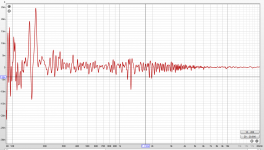True.
Fortunately, Camplo uses DSP.
In addition (superfluously):
"The value of mouth impedance will dictate the value of the throat impedance. There will usually be reflections at the mouth, and depending on the phase and magnitude of the reflected wave, it may increase or decrease the throat impedance. A horn with strong reflections will have large variations in throat impedance. Reflections also imply standing waves and resonance. To avoid this, it is important to terminate the horn correctly, so that reflections are minimized."
Fortunately, Camplo uses DSP.
In addition (superfluously):
"The value of mouth impedance will dictate the value of the throat impedance. There will usually be reflections at the mouth, and depending on the phase and magnitude of the reflected wave, it may increase or decrease the throat impedance. A horn with strong reflections will have large variations in throat impedance. Reflections also imply standing waves and resonance. To avoid this, it is important to terminate the horn correctly, so that reflections are minimized."
It should not be too difficult to add a provisional roundover just for testing.
Regards
Charles
Indeed, although the underlying phenomena can also have causes that are only partly or not solved at all with an additional mouth termination.
Think about the hypothetical ideal horn, which should provide a constant (purely resistive) load that matches the impedance of the driver, thus suppressing resonances.
Obviously, the mouth of Camplo's long horn is small compared to the wavelengths at low frequencies. This is one source of reflections.
Another possible source is the elliptical schape of the mouth that stretches the wavefront asymmetrically which may introduce additional energy storage (reactive impedance).
Also, we can only assume that the flare (rate) of camplo's horn does not give rise to interferences (and is therefore correct).
My latest posts may come across as very critical, but this is primarily on the basis of theoretical principles.
If we look at the measurements (especially the waterfall) of the smaller brother of Camplo's horn - with only the mid diaphram of the BMS 4590 connected, it becomes clear that the measurements largely correspond.
This 300 Hz variant is recommended for use > 500 Hz, since the irregularities and distortion increase sharply below it.
Therefore Camplo's horn seems usable from 300 Hz.
Camplo, maybe you can repeat the BD, or post a classic waterfall plot with different settings (time window etc.) and measured at several distance(s).
Based on the freq. response, more resonances should be visible in the BD below 500 Hz.
If the plots are as clean as your first BD, I wouldn't worry.
Based on the freq. response, more resonances should be visible in the BD below 500 Hz.
If the plots are as clean as your first BD, I wouldn't worry.
I asked the builder for phase and GD and they ignored the request 🤣 Electrical impedance would be nice too, wouldn't it...What do the impendence and phase curves look like??
Rob 🙂
Lord and weather permitting, I'll be able to pick the horns up from the airport tomorrow. Then I can take my own measurements at least, inside ones... since it will be raining...
Rain equals day off and no outside measurements lol
Customs closes at 4:30... A broker isn't needed
Imp. and phase should be similar to the eTrak 300, with the low end ripples shifted to the left.
Those horns are literally massive: approx. 85cm wide & deep, 50kg, 6cm wall thickness.
And are undoubtedly well-made:

I believe this test of the eTrak 300 has been posted before:

And are undoubtedly well-made:
I believe this test of the eTrak 300 has been posted before:
I did, but this one is even larger and the slices would be oriented differently. Waiting for a pair of DCX464 to try out on the ES horn.Didn't you mill a monster (radial) horn? 😉
Heres the bottom of the black n white pic...🤣
85cm axial length....86.5cm full width, 49cm full height
without roll over portion, 73x39.5.... which turns quickly into a flat plain as already seen.
Last edited:
ok I have to hit generate for the spectrogram to update, it doesn't auto update like Fr and GD, all is well.
Here's the burst decay using a 20ms window

Here's the burst decay using a 20ms window
Has anyone tried this 15" round horn? Appears new and pricing is good. I am thinking of a two-way with a CD that will reach 300-500hz.
https://www.ebay.com/itm/125217876097?ssPageName=STRK:MEBIDX:IT&_trksid=p2060353.m1438.l2649
https://www.ebay.com/itm/125217876097?ssPageName=STRK:MEBIDX:IT&_trksid=p2060353.m1438.l2649
You see, with the 20ms window you basically mute the resonance at 166 Hz after only ~3 periods - it almost disappears, yet the reality is that it takes much longer.Here's the burst decay using a 20ms window
Which driver did you use?Very crude measurement, mic pointing down into the horn 1" or less above mouth...horn facing ceiling, sitting on floor...100ms window for the FR...the setting doesn't seem to change Spectrogram view....I guess those are ungated?
View attachment 1057930
View attachment 1057932
View attachment 1057936
Rob
So the 100ms is more accurate but as I open the window, I potentially swamp the measurements with room.... gotcha...You see, with the 20ms window you basically mute the resonance at 166 Hz after only ~3 periods - it almost disappears, yet the reality is that it takes much longer.
Time to hit the back yard
Last edited:
- Home
- Loudspeakers
- Multi-Way
- Is it possible to cover the whole spectrum, high SPL, low distortion with a 2-way?
